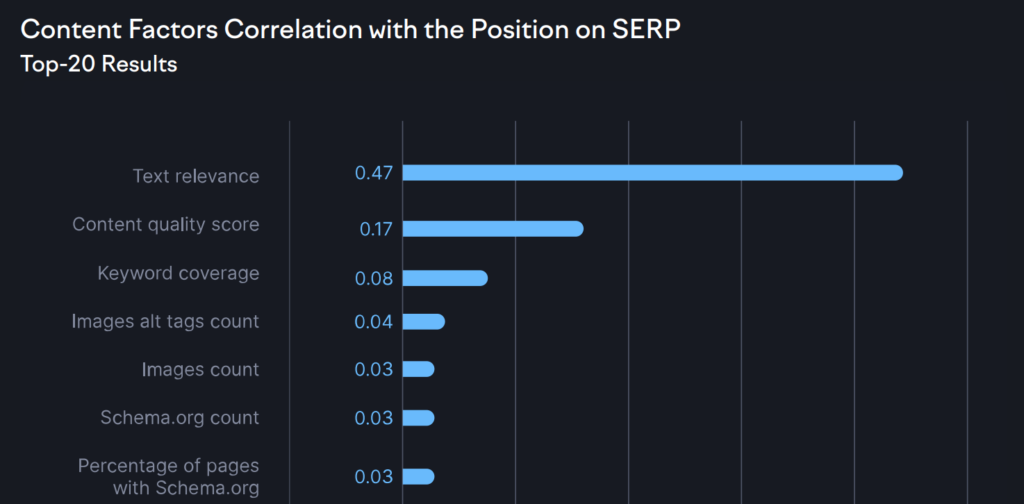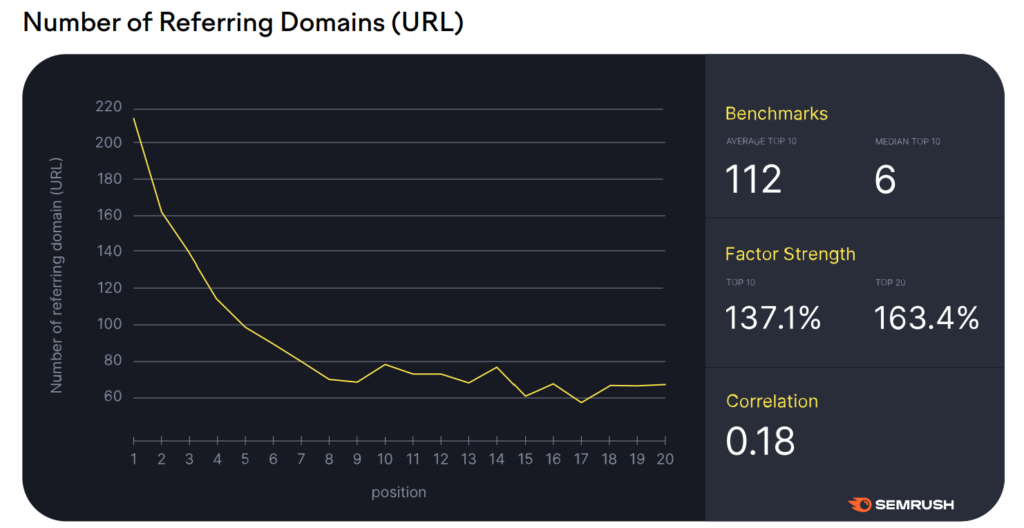
This guide was built upon three scientific studies that analyzed more than 11 million Google searches. These analysis were derived from Spearman correlation calculated between ranking signals and page ranks in a given search.
For example, if we consider the following hypothesis:
“Total number of backlinks correlates with better rankings”
We study the correlation between this signal and the rank that pages occupy in millions of searches.
WARNING: It’s important to note that correlation does not imply causation. That is, the fact that one of these signals has a high correlation with better ranking does not necessarily imply that making this modification to a page will improve its rank: it could be that the signal is a result of the rank itself and not vice versa (or maybe it’s a result of some other phenomenon that relates to ranking).
Ranking factor VS Ranking signal
Ranking signal:
A measurable feature of a web page that could influence ranking. Example: number of backlinks.
Ranking factor:
Quality that Google considers to position the content. For example: site authority.
The ranking factor “Site Authority” can be approximated by measuring the signal “Number of backlinks to the URL” but the signal “Number of backlinks to the Base Domain” could also be considered.
Results
We found that content relevance and quality had the greatest impact on ranking. But wait! Before you get discouraged and stop reading this blog; in the content section we will give you a good idea of how Google measures and rates relevance and quality.
The structure of the results analysis will be divided into three main factors:
We chose these three factors given that their analysis is shared between the three studies and they were the ones with the highest correlation. Links to the methodologies of each study are found at the end of the blog.
Content
The backlinko study found a high correlation between the relevance and topic completeness with rank.

This image shows on the X axis a measurement of the relevance made by clearscope.io and on the Y axis the position in the search.
Here we can see that those pages that are positioned in first place (1 on the Y axis) have much greater relevance and coverage of the topic than those that are positioned in 30th place.
Regarding the semrush study, in addition to finding a correlation with relevance (-.47), found a fairly high correlation with content quality (-.17). Google openly states that it uses BERT to analyze the semantics of content. This algorithm generates vectors between which distances can be calculated to analyze similarity between texts.

For the seo.co study, their results indicated a correlation of -.20 to -.35 between ranking and keyword entity inclusion. Essentially iterations of keywords in appropriate contexts that correspond to the search intent.
For example, “The Big Apple” in an urban context probably refers to New York City and is considered an entity for the search.
He also found correlations of similar magnitude (-.20 to -.35) with the number of keywords in the HTML tag. Although this is disputed by the other two studies; Backlinko mentions that the inclusion of keywords in the HTML tag as in the title, more than a ranking signal, is an “entry ticket” to be able to rank in searches.
Domain Authority
Domain authority is a ranking factor that seeks to prioritize those pages that come from reliable and well-known sources. The signals that are usually considered to measure this (by experts on the subject such as Semrush and Ahrefs) are the quality and quantity of backlinks.
The results of the three studies are quite conclusive: the number of links from other sites that refer both to the website (to any page on the domain) and to the specific URL that appears in the search, have a high correlation with better rankings.

The semrush study found that URLs in position 1 in searches have on average more than 200 backlinks from unique domains. However, he claims that the average is skewed by huge sites like Amazon; Let’s not lose hope!

It is also worth mentioning the proprietary metrics of semrush and ahrefs ( Authority Score ), both in the two studies (backlinko and semrush) presented a high correlation: higher than simply counting the different types of backlink. This is possibly because they take into consideration factors such as the quality of the backlinks, spam practices and the organic traffic that the sites receive.
User Experience
User experience is a more difficult ranking factor to track.
Google has recurringly changed its public position regarding the influence of loading speed on page ranking. Although the semrush study found a correlation of -.08 for upload speed factors such as TBT (Total blocking time) , none of the three studies found correlations that would suggest a conclusive result.

There are other signals that relate to the user experience, for example the time they stay on the site. In the case of the backlinko study, a strong relationship was found between this signal and positioning; with an average for the sites in the first position of 2.5 minutes of interaction.
Even so, it is difficult to determine if Google considers this for positioning; Not only have they publicly denied it, but logistically the time a user spends on a site is private information of the servers on which the site is hosted (although there could be tracking by browsers such as Google Chrome).
Conclusion
When you set out to learn SEO you always face the problem of the validity of the sources and the recommendations they provide you. That is why it is essential to refer to data and scientific studies of ranking factors.
These three studies indicate a clear relationship between the quality, completeness and relevance of the content with the positioning, as well as the number of domains that reference the site (as a signal of Authority).
Regarding user experience, it is difficult to find conclusive results, however the time a user spends on a site seems to be highly related to ranking.
There is a lot of opportunity to continue studying these signals and there are tools that already have databases with which you can work. There is always the option of crawling the web (Google Style), although it is a much more time-consuming and technical job.
Let’s support efforts to democratize knowledge and make the web a humane environment.
Resources
SEO.co. (n.d.). Google Ranking Factors. SEO.co. Retrieved fromhttps://seo.co/google-ranking-factors/#Factors-1-47-Statistical-Spearman-Correlation-035-to-020
Dean, B. (n.d.). How Google Ranks Websites. Backlinko. Retrieved from https://backlinko.com/search-engine-ranking#comprehensive-content-strongly-correlates-with-higher-rankings
SEMrush. (n.d.). Ranking Factors SEMrush Study. SEMrush. Retrieved from https://www.semrush.com/blog/ranking-factors-semrush-study/

Deja un comentario